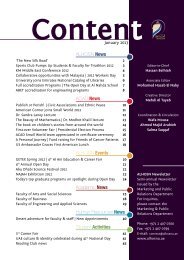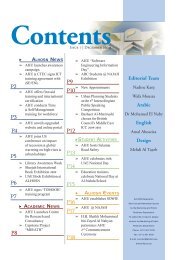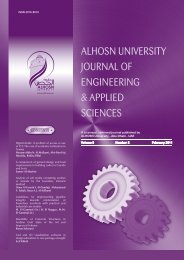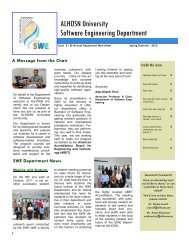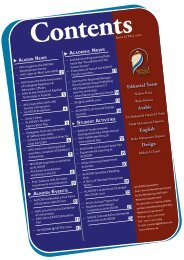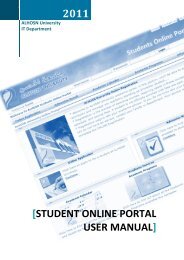ALHOSN University Catalogue Global Knowledge with Local Vision ...
ALHOSN University Catalogue Global Knowledge with Local Vision ...
ALHOSN University Catalogue Global Knowledge with Local Vision ...
You also want an ePaper? Increase the reach of your titles
YUMPU automatically turns print PDFs into web optimized ePapers that Google loves.
1. First Violation – A grade of zero on the quiz, exam, etc., or, in certain cases, a failing grade in<br />
the course.<br />
2. Second Violation – Suspension for a semester. In extreme circumstances, dismissal from<br />
the <strong>University</strong> is an available option.<br />
3. Third Violation – Dismissal from the <strong>University</strong><br />
Record Keeping and Procedures<br />
The designated Dean of the Faculty and the Dean of Student Affairs will keep all records of violations of<br />
academic integrity <strong>with</strong>in a confidential file in a secure area so that information may be kept to identify<br />
any repeat offenses by students.<br />
Records must be kept for a minimum of three years after the student has left the institution. In cases of<br />
dismissal from the university, a copy of the dismissal letter will be placed in the student’s confidential<br />
educational record file in the Dean of Student Affairs Office where it will be kept for eight years.<br />
Examinations<br />
1. All students must arrive and be seated in the Exam’s room at least 5 minutes before the start<br />
of the exam. No student will be permitted to enter the exam’s room after the first 20 minutes.<br />
2. Examinations during the term (e.g., mid-terms) shall be given only during the midterm<br />
exam week scheduled by the university, and may not be held at times other than the regularly<br />
scheduled period.<br />
3. A student who could not sit for any exam, test or quiz during the semester, for any<br />
reason (including medical excuses), will not be allowed to do make-up exams, tests or<br />
quizzes. The marks allocated for the exam, test or quiz will be accumulated and added to the<br />
Final Exam.<br />
4. Undergraduate students will not be allowed to have Take-Home Exams.<br />
5. All classes that normally permit undergraduates to enroll shall follow a standard<br />
examination schedule.<br />
6. Final examinations for summer session shall be scheduled during the final exam week<br />
scheduled by the university. However, if there are more than 17 students enrolled in the course,<br />
the mid-term will be scheduled by the Instructor in two different classes as required.<br />
7. Midterm examinations for summer sessions shall be given only during the regular class sessions.<br />
8. Students <strong>with</strong> mid-term or final examination conflicts or <strong>with</strong> three (or more) examinations in<br />
one calendar day shall inform the Provost Office so that conflicts will be eliminated. Instructors<br />
must agree to give an alternative examination to any student having examination conflicts or<br />
three (or more) examinations in one calendar day.<br />
9. Missing the Final Exam: A student who could not attend the Final Exam for an accepted reason<br />
(including medical excuses) will be given a grade of ‘I’ (Incomplete) and are required to take<br />
the make-up of the Final Exam in the following semester during the Final Exam Week. The<br />
Admissions and Registration Office will send notification to the Instructor of the Course to<br />
prepare and submit the examination to the Admissions and Registration Office, who will then<br />
schedule the exam. The student must request to sit for the make-up of the Final Exam. No<br />
student shall be allowed to take the make-up of the Final Exam at any other time unless<br />
approved by the Provost.<br />
Grade and Grading System<br />
1. Grades represent faculty appraisal of the quality of students’ work. Term grades are assigned<br />
by faculty members and can be changed only for a just cause and <strong>with</strong> administrative approval.<br />
2. Grade reports are sent to each student at the end of each semester.<br />
3. A letter grade and plus-minus system for evaluating academic performance is used for<br />
evaluating all undergraduate students. Each letter grade has a Grade Point value for each<br />
semester hour it represents. The hours and quality points are used in determining a student’s<br />
Grade Point Average for a semester’s work and in averaging grades for all work completed to<br />
find a student’s cumulative Grade Point Average.<br />
4. Academic eligibility for a student shall be determined by current regulations. The<br />
university adopts the following grading system (see Table below).<br />
34






